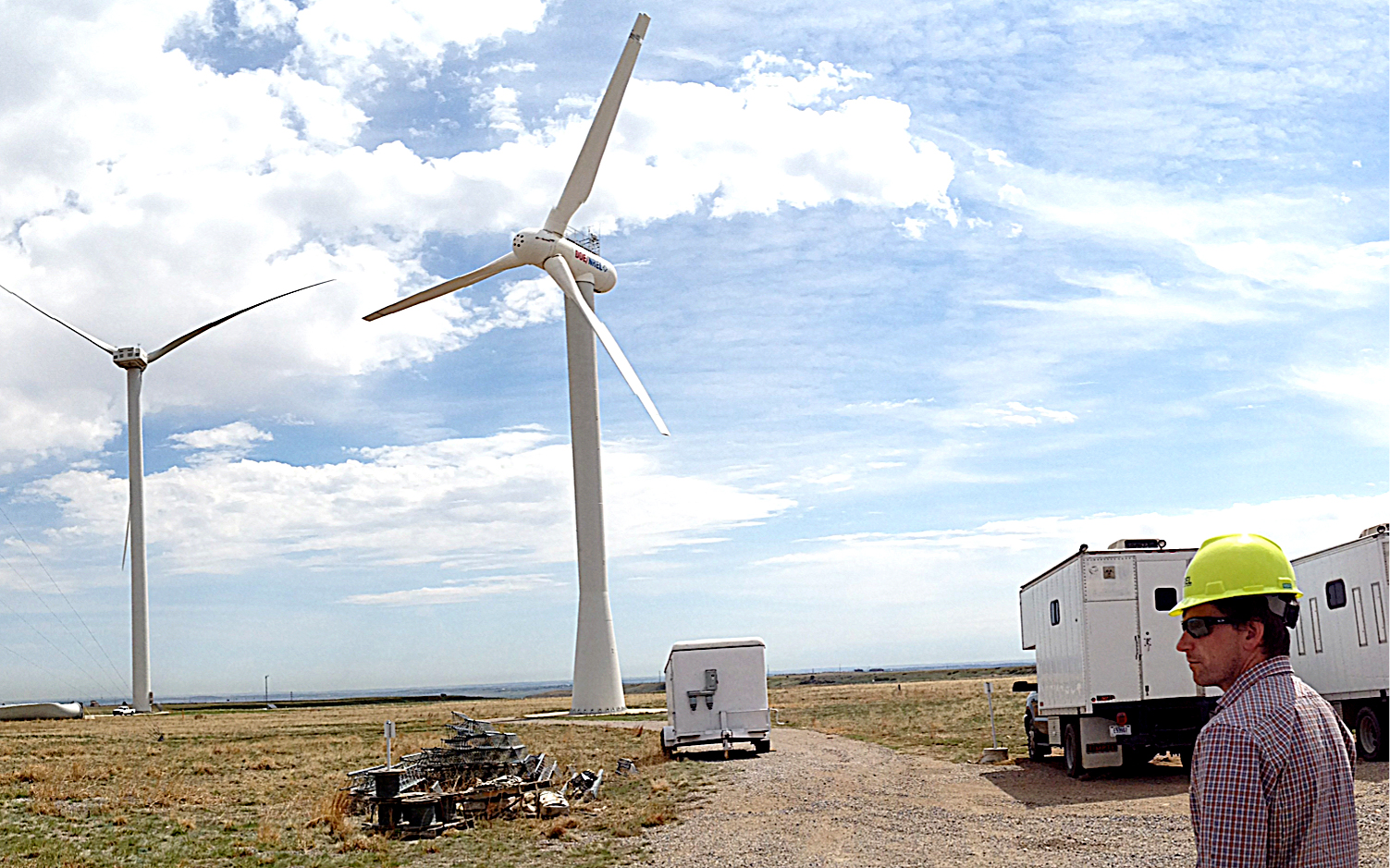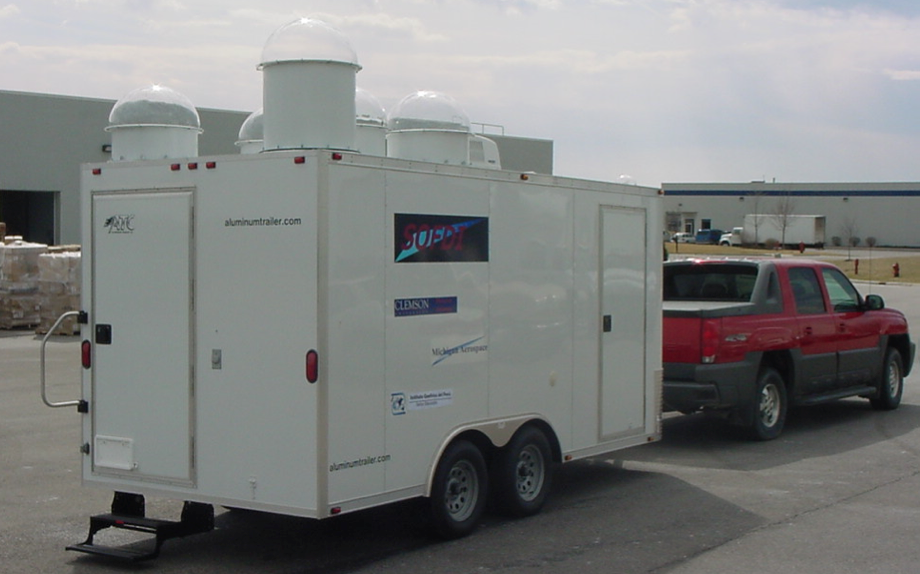Experience: Earth
Applying our skill sets closer to home, Michigan Aerospace has developed a number of technologies for land, sea, and at the boundaries. From ground-based atmospheric measurement systems to environmental monitoring to biomedical devices for early-stage disease detection, we strive to make a positive impact on planet Earth and every person who lives here.
We developed the world’s most advanced light detection and ranging (LIDAR) system. It measures wind speed, direction, temperature, density, water vapor, and other properties simultaneously to give you the most accurate picture of the atmosphere – before you fly into it.

Using a patented ultraviolet (UV) detection method, AeroForecast provides real-time, continuous measurements, day and night, upwards of 50km. Measurements can be made in completely clear air, with or without the presence of aerosols. Competing LIDAR technologies can only guarantee measurements where there are aerosols, often not much higher than the boundary layer.
AeroForecast® Launch LIDAR technology allows for the recording of wind measurements at the highest altitude of any ground-based LIDAR. We are the only company on the planet to provide these measurements from space, airborne and ground assets. Beginning with ground stations in New Hampshire and on Mauna Loa, Hawaii, we now deliver fully autonomous transportable solutions.
Founded in 2009, OptoAtmospherics, Inc. (Opto) was established to commercialize Michigan Aerospace technology for wind energy applications.

Opto is a venture-funded company with an exclusive license to develop and commercialize the technology for the wind energy market. The technologies include transformational ultraviolet (UV) LIDAR for atmospheric measurements and novel predictive analytics software for condition-based monitoring and controls.
The UV-Lite LIDAR is currently being field tested on a wind turbine. Applications include LIDAR-integrated feed-forward controls to prevent fatigue and extreme load damage, improved pointing efficiency, and performance validation.
Michigan Aerospace was funded by NOAA to demonstrate long-range wind LIDAR technology for future satellite missions to measure global tropospheric winds.

The two GroundWinds instruments—one near Mt. Washington in New Hampshire and the other at the Mauna Loa Observatory in Hawaii—successfully demonstrated long-range (20 km+), range-resolved direct-detection Doppler LIDAR atmospheric measurements (wind speed, direction, temperature and density). Many of our key LIDAR enhancement technologies, such as “light recycling” and circle-to-line optics (CLIO), were successfully implemented during the GroundWinds program. The Hawaii LIDAR was upgraded in 2013 to extend its operating range.
A multi-wavelength LIDAR system was developed by Michigan Aerospace for the National Institute of Standards and Technology (NIST) for measuring aerosol properties critical to understanding climate change, atmospheric chemistry, and air quality.

This mobile facility provides unprecedented capability in characterizing atmospheric composition and chemistry. Advancements in aerosol characterization and the measurement of atmospheric transmittance are possible through the separation of molecular and aerosol scattering. The LIDAR measures aerosol optical depth, backscatter, depolarization, molecular temperature, molecular density, and wind velocity along the laser propagation direction. Improved atmospheric transmittance and aerosol characterization capabilities developed through this program will advance air quality and climate-change related measurements.
We have developed a novel smart stormwater control framework that, when deployed at scale, will reduce the occurrence of combined and sanitary sewer overflows thereby improving the water quality of the Great Lakes and their tributaries.

The framework will be pilot tested at neighborhood-scale densities in Milwaukee, Ann Arbor and Toledo, reducing occurrences of localized flooding and resulting water quality impairments during the project period.
The team will create and test a scalable computing framework that optimizes the management of sump pumps, rain barrels and stormwater outlets by fusing real-time sensor data and location-specific weather forecasting with control algorithms. The algorithms will establish relationships between a number of meteorological, hydrologic and hydraulic variables and identify the optimal set of stormwater asset operational decisions, given real-time conditions, at any point in time.
The computing framework will be dynamic and will evolve (i.e., learn) over time. This will be the first known application of Bayesian networks to automate operational infrastructure decisions. Customers envisioned for the computing framework are water utilities seeking to optimize the use of distributed green infrastructure assets to improve stormwater management decision-making. A smartphone application will also be developed for participating private homeowners to monitor the performance of sump pumps and rain barrels.
Plans are already being made to expand the capabilities of the network into a more general framework for water management and weather monitoring/forecasting, including specific sensors and analytics to enable more effective management of wetlands, water quality, agriculture, and drought stricken regions.
Acousys Biodevices is paving the way to earlier detection and capture of circulating tumor cells (CTCs).

Through its patented photoacoustic technology, the company has demonstrated unprecedented performance in identifying and capturing melanoma tumor cells. The technology is applicable to a broad range of cancers, bacteria, viruses and other pathogens.
Michigan Aerospace is providing engineering services and Springmatter is providing a combination of investment, FDA regulatory guidance, product development, manufacturing, and business support services to accelerate the introduction of Acousys technology into trials.
LifeSpan Behavioral Technologies is a small start-up company with a big vision.

Based in Atlanta, GA, their goal is to improve the quality of life for individuals and families challenged by neurodevelopmental disorders by offering groundbreaking diagnostic and therapeutic tools to both physicians and patients.
Michigan Aerospace is providing R&D engineering services and Springmatter is providing LifeSpan with a combination of product development resources, manufacturing & business support services, and debt financing to help them make their vision a reality.
Most adults are not regularly screened for diabetes. Existing screening methods are invasive, requiring fasting and blood draws. As a result, there are more than 8 million undiagnosed diabetics in the US (26.5M total) and 79 million pre-diabetics.

As most adults visit a primary eye care practice for reading glasses starting at the age of 40, primary eye care is a perfect initial venue for screening for diabetes and monitoring disease progression. Michigan Aerospace is helping OcuSciences build products that can rapidly and non-invasively detect and monitor retinal metabolic dysfunction due to a variety of diseases, including diabetes and macular degeneration, at an earlier stage than currently possible and before irreversible cell damage occurs.
The initial focus is on early detection of diabetes and pre-diabetes and the monitoring of disease progression due to retinal cell damage.
In cooperation with Clemson University, Michigan Aerospace designed and built the SOFDI (Second-generation Optimized Fabry-Perot Doppler Imager) instrument to observe upper atmospheric winds and temperatures.

It is modeled after the HRDI (High Resolution Doppler Imager) interferometer that operated successfully aboard the Upper Atmosphere Research Satellite (UARS) from November 1991 through April 2005. SOFDI offers a broad range of applications pertaining to the observations of mesosphere and thermosphere airglow emissions and uses a number of innovative optical techniques that allow for day and night measurements of key spectral parameters. These results are yielding a wealth of information for the aeronomy community, including the mapping of upper atmospheric winds and detailed investigations of the composition and dynamics of the upper atmosphere. The instrument is in operation in Peru, near the Earth’s magnetic equator.
Michigan Aerospace, in conjunction with Southern Methodist University, has developed a highly sensitive, low cost miniature seismometer based on micro-opto-electromechanical systems technology.

Micro-g sensitivity has already been demonstrated and our micro-scale seismometer is expected to detect accelerations as small as 1 nano-g, with a dynamic range of 120 dB. The unique sensitivity is due to the high “Q-factor” of the sensing element. In addition, the device is rugged, rapidly-deployable, and capable of unattended operation and interrogation in real time. The seismometer has potential application to a broad range of activities, including geological research (mining and oil prospecting), earth sciences (early warning for earthquakes, volcanoes, and tsunamis), space exploration (satellite drag measurements, docking, navigation), homeland security (footstep detection, tampering, entry, and illicit activities), and building and vehicle safety.







